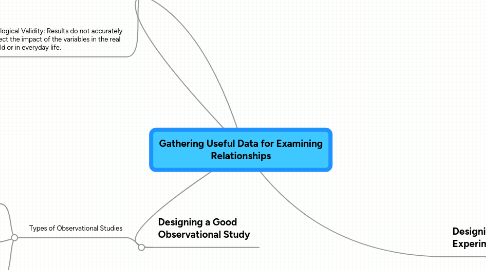
1. Speaking the Language of Research Studies
1.1. Types of research studies
1.1.1. Observational Studies
1.1.1.1. Researchers observe or question the participants about opinions, behaviors, or outcomes.
1.1.2. Experiments
1.1.2.1. researchers manipulate something and measure the effect of the manipulation on some outcome of interest.
1.1.2.2. Randomized experiments
1.1.2.2.1. experiments in which the participants are randomly assigned to participate in one condition or another
1.2. Units, Subjects, Participants
1.2.1. Unit: Used to indicate a single individual or object being measured.
1.2.1.1. Experimental Unit: The most basic entity to which different treatments can be assigned.
1.2.2. Subjects: When the experimental units are people
1.2.3. Participants: In experiments and observational studies, subjects may also be called participants
1.3. Explanatory and Response Variables
1.3.1. Explanatory variable is one that may explain or may cause differences in a response variable.
1.3.2. Response variable can also be known as an outcome or dependent variable.
1.3.2.1. dependent variable: the values are sometimes thought to depend on the values of the explanatory variable.
1.3.3. Explanatory variables can also be known as independent variables
1.4. Confounding Variable
1.4.1. Confounding variable: a variable that both affects the response variable and also is related to the explanatory variable
1.4.2. Lurking Variable: describes a potential confounding variable that is not measured and is not considered in the interpretation of the study.
2. Designing a Good Observational Study
2.1. Types of Observational Studies
2.1.1. Retrospective: The data is from the past
2.1.2. Prospective: follow participants into the future and record relevant events and variables
2.1.3. Case-control study: cases who have a particular attribute or condition are compared to controls who do not
3. Difficulties and Disaster in Experiments and Observational Studies
3.1. Interacting Variables: sometimes a second explanatory variable interacts with the principal explanatory variable in its relationship with the response variable.
3.2. Hawthorne and Experimenter Effects
3.2.1. Hawthorne: participants in an experiments respond differently than they otherwise would, just because they are in an experiment
3.2.2. Experimenter: Numerous ways in which the experimenter can bias the results
3.3. Ecological Validity: Results do not accurately reflect the impact of the variables in the real world or in everyday life.
4. Designing a Good Experiment
4.1. Participants in randomized experiments
4.1.1. Volunteers
4.2. Randomization: random assignment to treatments or conditions
4.3. Control Groups, Placebos, and Blinding
4.3.1. Control groups: treated identically in all respects except they don't receive the active treatment
4.3.2. Placebos: A placebo looks like the real drug but has no active ingredient
4.3.2.1. Placebo effect: so strong that most drug research is done by randomly giving half the participants a placebo instead of the drug.
4.3.3. Blinding
4.3.3.1. Double-blind: neither the participant nor the researcher taking the measurements knows who had which treatment
4.3.3.2. Single-blind: the participants do not know which treatment they have been assigned
4.3.4. New node
4.4. Pairing and Blocking
4.4.1. Matched-pair designs: experimental designs that use either two matched individuals or the same individual to receive each of two treatments
4.4.2. Blocks: experimental units are divided into homogeneous groups
4.5. Design Terminology
4.5.1. Completely Randomized design: If treatments are randomly assigned to experimental units without using matched pairs or blocks
4.5.2. Matched-pair design: When matched pairs are used
4.5.3. Randomized block design: When blocks are used
